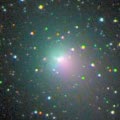
|
Now it is so bright as 8.0 mag (Aug. 11, Juan Jose Gonzalez). It will be observable at 8-10 mag in good condition for a long time until late autumn.
Date(TT) R.A. (2000) Decl. Delta r Elong. m1 Best Time(A, h)
Aug. 15 20 22.87 22 22.4 2.313 3.150 139 8.0 22:45 (180, 33)
Aug. 22 20 7.76 18 57.6 2.334 3.158 137 8.1 22:03 (180, 36)
|
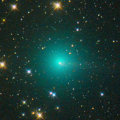
|
It brightened up to 6.7 mag in June (June 9, Marco Goiato). Now it is fading, but still bright as 9.5 mag (Aug. 8, Marco Goiato). In the Northern Hemisphere, it is observable until mid August in the evening low sky. In the Southern Hemisphere, it will be getting lower after this, and will be too low to observe in late August.
Date(TT) R.A. (2000) Decl. Delta r Elong. m1 Best Time(A, h)
Aug. 15 12 41.23 0 57.9 2.461 1.921 47 9.7 18:53 (111, 26)
Aug. 22 12 44.28 2 12.1 2.604 1.953 40 10.1 18:58 (107, 20)
|
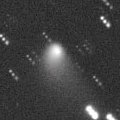
|
It brightened up to 9.8 mag on June 13 (Marco Goiato). Now it is not observable. But it keeps as bright as 10-11 mag for a long time untio 2010 spring. In the Northern Hemisphere, it will appear in the morning sky in early October, then it keeps observable at 10 mag in good condition for a long time. In the Southern Hemisphere, it will locate extremely low only after this.
Date(TT) R.A. (2000) Decl. Delta r Elong. m1 Best Time(A, h)
Aug. 15 9 19.73 2 40.6 3.312 2.333 12 9.8 5:15 (272, -8)
Aug. 22 9 32.85 3 24.0 3.296 2.313 11 9.8 5:07 (271, -7)
|
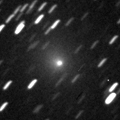
|
It brightened up to 8.5 mag in May and June (May 26, Juan Jose Gonzalez). Now it is fading, but still bright as 9.5 mag (Aug. 8, Marco Goiato). It will never be observable again in the Northern Hemisphere. In the Southern Hemisphere, it keeps observable for a long time after this in the evening sky.
Date(TT) R.A. (2000) Decl. Delta r Elong. m1 Best Time(A, h)
Aug. 15 10 36.16 -37 8.2 1.919 1.539 53 9.9 18:53 ( 59, 22)
Aug. 22 11 2.39 -40 52.7 1.967 1.605 54 10.1 18:58 ( 55, 23)
|
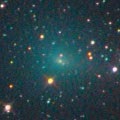
|
It brightened up to 8.8 mag in May and June (May 19, Juan Jose Gonzalez). Now it is still bright as 10.2 mag (Aug. 11, Juan Jose Gonzalez). It will be bright at 9-10 mag for a long time until autumn.
Date(TT) R.A. (2000) Decl. Delta r Elong. m1 Best Time(A, h)
Aug. 15 22 56.43 -12 26.4 0.784 1.773 160 10.0 1:24 (180, 67)
Aug. 22 22 52.83 -13 21.5 0.802 1.804 168 10.2 0:53 (180, 68)
|
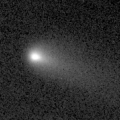
|
It has already brightened up to 11.3 mag (July 25, Juan Jose Gonzalez). It will be observable at 10-11 mag in a good condition for a long time from summer to winter.
Date(TT) R.A. (2000) Decl. Delta r Elong. m1 Best Time(A, h)
Aug. 15 2 58.35 -2 55.1 0.598 1.265 100 11.5 5:15 (184, 58)
Aug. 22 3 29.58 -3 3.5 0.585 1.246 99 11.2 5:07 (190, 58)
|

|
It was bright as 8-9 mag in April and May. Now it is not observable. But it will appear in the morning sky again at 12 mag in late August, then it will be fading slowly in the low sky. In the Southern Hemisphere, it keeps observable in good condition for a long time after August.
Date(TT) R.A. (2000) Decl. Delta r Elong. m1 Best Time(A, h)
Aug. 15 7 37.71 6 36.4 2.733 1.930 30 11.5 5:15 (254, 10)
Aug. 22 7 44.41 3 43.8 2.737 2.002 35 11.7 5:07 (254, 15)
|

|
It reaches up to 11 mag in summer. However, the condition of this apparition is worst. We can not observe it at all.
Date(TT) R.A. (2000) Decl. Delta r Elong. m1 Best Time(A, h)
Aug. 15 9 46.42 19 28.1 2.220 1.216 5 11.6 18:53 (101,-19)
Aug. 22 10 13.47 17 26.8 2.226 1.225 6 11.7 18:58 ( 98,-19)
|
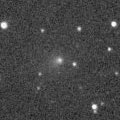
|
It is so bright as 11.2 mag visually (Aug. 8, Marco Goiato), much brighter than this ephemeris. It will be 10 mag in autumn. It keeps observable for a long time until 2010 February. But in the Northern Hemisphere, it keeps very low after this. It locates a bit higher in the Southern Hemisphere.
Date(TT) R.A. (2000) Decl. Delta r Elong. m1 Best Time(A, h)
Aug. 15 13 55.46 -12 54.4 1.529 1.505 69 12.0 18:53 (113, 49)
Aug. 22 14 12.13 -14 41.1 1.542 1.475 66 11.8 18:58 (107, 47)
|
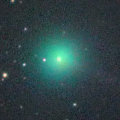
|
It has been observed bright as 8-9 mag from April to June. Now it is fading, but still bright as 11.0 mag (July 12, Marco Goiato). In the Southern Hemisphere, it keeps observable in a good condition for a long time. In the Northern Hemisphere, it will never be observable again.
Date(TT) R.A. (2000) Decl. Delta r Elong. m1 Best Time(A, h)
Aug. 15 9 43.81 -51 5.5 2.346 2.130 65 12.6 18:53 ( 41, 20)
Aug. 22 9 55.69 -50 41.6 2.485 2.210 62 12.9 5:07 (319, 20)
|

|
Now it is very bright as 11.9 mag (July 12, Marco Goiato). However, it will be too low to observe soon. It will appear in the morning sky at 15 mag in early 2010. But it locates somewhat low in the Northern Hemisphere.
Date(TT) R.A. (2000) Decl. Delta r Elong. m1 Best Time(A, h)
Aug. 15 12 20.69 -2 24.9 2.803 2.183 43 13.2 18:53 (105, 24)
Aug. 22 12 34.01 -3 58.3 2.857 2.188 40 13.2 18:58 (100, 21)
|

|
It passed near by the earth in late February, and it reached up to 4.9 mag (Feb. 23, Juan Jose Gonzalez). It had been unobservable for a while, but it is appearing in the morning sky again. Now it is 14.9 mag (Aug. 14, Ken-ichi Kadota). In the Northern Hemisphere, it is observable at 15 mag in good condition from autumn to winter. It may be visible visually.
Date(TT) R.A. (2000) Decl. Delta r Elong. m1 Best Time(A, h)
Aug. 15 7 17.64 21 5.5 3.977 3.190 34 14.0 5:15 (240, 5)
Aug. 22 7 18.99 21 0.5 3.966 3.264 40 14.1 5:07 (237, 8)
|
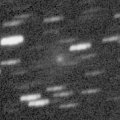
|
Appearing in the morning sky. Now it is 12.8 mag and visible visually (July 25, Juan Jose Gonzalez). It will be getting higher gradually while fading slowly after this.
Date(TT) R.A. (2000) Decl. Delta r Elong. m1 Best Time(A, h)
Aug. 15 7 8.15 26 26.3 2.246 1.562 37 14.2 5:15 (234, 3)
Aug. 22 7 28.49 25 31.9 2.254 1.602 39 14.3 5:07 (235, 4)
|

|
Now it is not observable. It will appear in the morning sky in September.
Date(TT) R.A. (2000) Decl. Delta r Elong. m1 Best Time(A, h)
Aug. 15 8 59.71 17 20.3 7.149 6.153 9 14.2 5:15 (257,-12)
Aug. 22 9 4.89 16 54.5 7.125 6.155 15 14.2 5:07 (256, -9)
|

|
It brightened up to 11.5 mag in last summer (Aug. 4, Marco Goiato). Now it is 15.9 mag (Aug. 12, H. Sato). It keeps observable in good condition for a long time in the Southern Hemisphere. It will be observable again also in the Northern Hemisphere after September. It will keep 15-16 mag until next spring.
Date(TT) R.A. (2000) Decl. Delta r Elong. m1 Best Time(A, h)
Aug. 15 6 30.36 -37 17.3 4.097 3.830 67 14.4 5:15 (290, 46)
Aug. 22 6 33.88 -37 32.6 4.111 3.878 69 14.5 5:07 (289, 49)
|

|
It brightened up to 9.8 mag in winter (Dec. 28, Juan Jose Gonzalez). It faded down to 12.5 mag in May (May 26, Juan Jose Gonzalez), and became unobservable. Now it is not observable, however, it will be observable in good condition again in winter at 15 mag. Then it may be still visible visually.
Date(TT) R.A. (2000) Decl. Delta r Elong. m1 Best Time(A, h)
Aug. 15 9 19.61 16 55.3 5.232 4.225 5 14.4 5:15 (260,-16)
Aug. 22 9 26.54 16 1.8 5.271 4.279 10 14.5 5:07 (259,-13)
|

|
Now it is 12.5 mag and visible visually (July 24, Juan Jose Gonzalez). It will be too low to observe soon. It will brighten up to 12-13 mag in 2010 summer.
Date(TT) R.A. (2000) Decl. Delta r Elong. m1 Best Time(A, h)
Aug. 15 12 58.29 -0 23.1 3.231 2.720 51 14.6 18:53 (113, 30)
Aug. 22 13 7.53 -1 41.4 3.281 2.702 47 14.6 18:58 (108, 27)
|

|
First return of a new bright periodic comet. It was observed as an asteroid in June. Now it is 17.3 mag by CCD observations (Aug. 3, Siding Spring Survey). However, because it looks very diffuse, the total magnitude can be around 14-15 mag. The condition in this apparition is very good. The comet will pass near by the earth and is expected to reach up to 13-14 mag. Now it locates very low in the Northern Hemisphere, but it keeps observable high until early August in the Southern Hemisphere. It is not observable in latter half of August. In the Northern Hemisphere, it appears in the morning sky at 15 mag in late August, then it keeps observable in a good condition. Maybe it becomes visible visually.
Date(TT) R.A. (2000) Decl. Delta r Elong. m1 Best Time(A, h)
Aug. 15 9 23.30 -1 30.7 0.192 0.830 16 14.6 5:15 (277, -6)
Aug. 22 8 43.34 8 3.6 0.232 0.798 20 14.8 5:07 (260, 0)
|
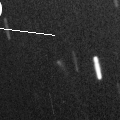
|
Now it is 14.5 mag (July 30, H. Sato). It keeps observable in good condition at 15 mag until late autumn.
Date(TT) R.A. (2000) Decl. Delta r Elong. m1 Best Time(A, h)
Aug. 15 0 36.20 22 49.2 3.258 3.901 122 15.0 3:03 (180, 32)
Aug. 22 0 30.52 24 14.4 3.186 3.905 129 14.9 2:30 (180, 31)
|
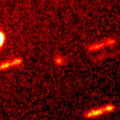
|
Although it had been unobservable for a long time, it is appearing in the morning sky now. It must be already bright as 15 mag. It will be observable bright as 9-10 mag in a good condition for a long time from winter to spring. It keeps observable until 2010 autumn when it fades down to 16 mag.
Date(TT) R.A. (2000) Decl. Delta r Elong. m1 Best Time(A, h)
Aug. 15 7 8.94 20 45.0 3.118 2.376 36 15.1 5:15 (239, 7)
Aug. 22 7 23.28 20 21.0 3.026 2.335 39 14.9 5:07 (238, 8)
|

|
Now it is 15.2 mag (Aug. 3, H. Sato). It passes the perihelion in September, and now it is brightest. It keeps observable in good condition in the Southern Hemisphere. It is not observable now in the Northern Hemisphere. But it will appear in the evening sky at the end of September, and then it will be getting higher while fading.
Date(TT) R.A. (2000) Decl. Delta r Elong. m1 Best Time(A, h)
Aug. 15 13 16.27 -55 9.1 0.868 1.252 83 15.1 18:53 ( 43, 52)
Aug. 22 13 54.65 -56 3.0 0.836 1.231 82 15.1 18:58 ( 41, 53)
|
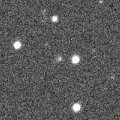
|
Now it is 15.9 mag (July 19, Ken-ichi Kadota). It will brighten up to 15 mag in 2009 and 2010, and will be observable for a long time in good condition.
Date(TT) R.A. (2000) Decl. Delta r Elong. m1 Best Time(A, h)
Aug. 15 16 14.44 50 20.4 2.722 2.817 84 15.2 18:53 (177, 5)
Aug. 22 16 0.56 47 24.5 2.787 2.807 80 15.2 18:58 (170, 7)
|
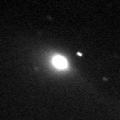
|
It brightened very rapidly, faster than expected, and reached up to 9.3 mag in spring (Mar. 26, Juan Jose Gonzalez). However, it will never be observable again in this apparition.
Date(TT) R.A. (2000) Decl. Delta r Elong. m1 Best Time(A, h)
Aug. 15 10 32.97 14 4.6 3.199 2.226 13 15.3 18:53 (102, -7)
Aug. 22 10 46.25 12 43.2 3.267 2.279 10 15.6 18:58 ( 98,-10)
|
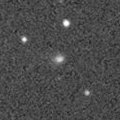
|
It has brightened up to 14 mag in outburst in 2008 August. Now it is bright as 14.3 mag (July 13, H. Sato), brighter than originally expected.
Date(TT) R.A. (2000) Decl. Delta r Elong. m1 Best Time(A, h)
Aug. 15 21 6.08 -41 15.1 2.140 3.071 151 15.3 23:29 ( 0, 84)
Aug. 22 21 2.09 -41 49.2 2.187 3.086 147 15.4 22:58 ( 0, 83)
|
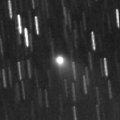
|
New bright periodic comet. It is still bright as 13.3 mag and visible visually (July 13, Carlos Labordena). Moving northwards in the Milky Way. In the Northern Hemisphere, the condition becomes good after this. But the comet will fade out rapidly. It will be fainter than 15 mag in August, and fainter than 18 mag in October.
Date(TT) R.A. (2000) Decl. Delta r Elong. m1 Best Time(A, h)
Aug. 15 18 47.76 4 7.8 0.749 1.625 133 15.5 21:12 (180, 51)
Aug. 22 18 54.72 3 45.1 0.827 1.671 130 15.8 20:52 (180, 51)
|

|
New periodic comet. It has already passed the perihelion in late June. But unexpectedly, it keeps unusual brightening very rapidly after that. Now it became bright as 15.0 mag (July 30, D. Chestnov). It keeps observable in the evening low sky for a while after this. But it may fade out very rapidly.
Date(TT) R.A. (2000) Decl. Delta r Elong. m1 Best Time(A, h)
Aug. 15 13 26.69 -4 11.6 1.671 1.449 59 15.5 18:53 (116, 38)
Aug. 22 13 49.53 -6 17.8 1.728 1.484 58 15.8 18:58 (112, 38)
|

|
It reached to 10.9 mag in 2008 spring (May 11, Marco Goiato). It is fading slowly. Now it is 13.4 mag (June 1, Juan Jose Gonzalez), still visible visually. It keeps bright as 13-14 mag for a long time after this until summer.
Date(TT) R.A. (2000) Decl. Delta r Elong. m1 Best Time(A, h)
Aug. 15 16 6.32 33 13.6 4.751 4.823 88 15.6 18:53 (175, 22)
Aug. 22 16 8.80 32 27.1 4.864 4.874 84 15.7 18:58 (168, 22)
|

|
Now it is 13.4 mag and visible visually (July 18, Jose Carvajal). It had been bright and visible visually around 13 mag from spring to autumn in 2008. It will be visible visually at 14 mag again until summer.
Date(TT) R.A. (2000) Decl. Delta r Elong. m1 Best Time(A, h)
Aug. 15 13 4.04 32 51.7 7.545 6.940 50 15.7 18:53 (139, 7)
Aug. 22 13 4.63 32 22.7 7.632 6.969 46 15.7 18:58 (133, 3)
|

|
Now it is 15.7 mag (Aug. 11, Ken-ichi Kadota). It keeps 15 mag until winter. It keeps observable in a good condition in the Southern Hemisphere. But in the Northern Hemisphere, it will be getting lower gradually, and it is only observable until late autumn.
Date(TT) R.A. (2000) Decl. Delta r Elong. m1 Best Time(A, h)
Aug. 15 0 26.64 1 36.1 2.151 2.959 135 15.9 2:54 (180, 53)
Aug. 22 0 21.48 -1 48.8 2.040 2.923 144 15.7 2:21 (180, 57)
|

|
Now it is 16.2 mag (Aug. 13, Ken-ichi Kadota), brightening as expected. It will reach up to 12 mag in 2012, and will be observable visually at 12-13 mag for a long time from 2011 to 2013. In 2009, it is observable in good condition at 16 mag from summer to autumn. In the Northern Hemisphere, the comet will be low around its brightest seasons.
Date(TT) R.A. (2000) Decl. Delta r Elong. m1 Best Time(A, h)
Aug. 15 22 27.50 5 2.5 7.729 8.672 157 15.8 0:55 (180, 50)
Aug. 22 22 22.95 4 41.4 7.664 8.636 162 15.8 0:23 (180, 50)
|

|
Now it is 17.1 mag (July 26, Ken-ichi Kadota). It will brighten rapidly after this. It will reach to 12 mag and become visible visually in winter. In the Northern Hemisphere, it keeps observable in good condition for a long time after this until 2010 spring when it fades out.
Date(TT) R.A. (2000) Decl. Delta r Elong. m1 Best Time(A, h)
Aug. 15 4 21.25 13 31.9 2.274 2.263 76 16.4 5:15 (208, 37)
Aug. 22 4 33.48 13 36.7 2.176 2.239 80 16.2 5:07 (206, 37)
|

|
Appearing in the morning sky. It has not been recovered yet. But it must have already brightened up to 16.5 mag. It will be getting higher rapidly after this, and will be observable in good condition at 16 mag in autumn.
Date(TT) R.A. (2000) Decl. Delta r Elong. m1 Best Time(A, h)
Aug. 15 5 35.75 27 25.1 2.334 1.986 57 16.5 5:15 (218, 16)
Aug. 22 5 49.19 29 26.4 2.279 2.003 61 16.4 5:07 (216, 15)
|
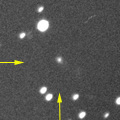
|
Now it is 16.4 mag (June 12, Ken-ichi Kadota). It will reach to 15 mag in 2010. It keeps observable for a long time after this in the Northern Hemisphere.
Date(TT) R.A. (2000) Decl. Delta r Elong. m1 Best Time(A, h)
Aug. 15 15 6.95 8 7.8 5.643 5.567 80 16.7 18:53 (152, 43)
Aug. 22 15 9.12 8 3.5 5.711 5.535 74 16.7 18:58 (143, 40)
|
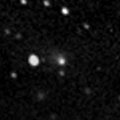
|
It brightened up to 15-16 mag in 2008 summer. Now appearing in the morning sky again. It keeps observable at 17 mag in good condition for a long time from summer to winter.
Date(TT) R.A. (2000) Decl. Delta r Elong. m1 Best Time(A, h)
Aug. 15 3 36.22 28 34.0 2.949 3.011 83 17.0 5:15 (192, 25)
Aug. 22 3 42.07 29 26.1 2.870 3.025 88 17.0 5:07 (188, 25)
|
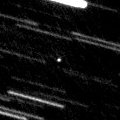
|
It passed the perihelion in June, but it was not observable, too close to the sun. Although it was predicted to be 13.5 mag, the STEREO spacecraft revealed that it brightened up to 10-11 mag, much brighter than expected. Now it is 15.8 mag (July 17, Michael Jager). It keeps observable at 16-17 mag until late autumn.
Date(TT) R.A. (2000) Decl. Delta r Elong. m1 Best Time(A, h)
Aug. 15 4 38.26 43 48.1 1.179 1.257 69 17.0 5:15 (200, 7)
Aug. 22 4 35.84 45 12.2 1.169 1.350 76 17.1 5:07 (195, 7)
|

|
It reached up to 14 mag in 2008 autumn. It is still bright as 16.0 mag (July 30, H. Sato). It keeps observable around 17 mag in a good condition for a while.
Date(TT) R.A. (2000) Decl. Delta r Elong. m1 Best Time(A, h)
Aug. 15 22 44.70 19 17.4 3.907 4.753 142 17.3 1:12 (180, 36)
Aug. 22 22 33.97 18 36.1 3.903 4.796 148 17.3 0:34 (180, 36)
|
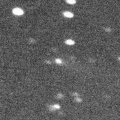
|
It was observed at 17.5 mag in 2008 summer. It is also observable at 17.5 mag in 2009 autumn. In the Northern Hemisphere, it located somewhat low in 2008, but it becomes observable in good condition in 2009. However, it is 19.0 mag recently (July 26, Ken-ichi Kadota), much fainter than this ephemeris.
Date(TT) R.A. (2000) Decl. Delta r Elong. m1 Best Time(A, h)
Aug. 15 1 12.18 16 5.0 3.228 3.824 119 17.6 3:39 (180, 39)
Aug. 22 1 11.47 16 23.6 3.147 3.827 125 17.5 3:11 (180, 39)
|
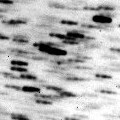
|
Now it is 17.0 mag (June 26, Charles Bell). The condition is good in this apparition. It will approach to the earth down to 0.38 A.U., and will be observable in good condition at 16.5 mag in November. It keeps observable until that time after this. But it locates somewhat low in the Northern Hemisphere.
Date(TT) R.A. (2000) Decl. Delta r Elong. m1 Best Time(A, h)
Aug. 15 16 5.87 -18 53.4 0.690 1.329 100 17.6 18:53 (161, 73)
Aug. 22 16 12.02 -18 47.3 0.682 1.274 95 17.6 18:58 (143, 71)
|

|
It was observed around 17 mag from autumn to winter in 2008. It has not been observed since January, but now it is observable in good condition again. It will fade out gradually after this.
Date(TT) R.A. (2000) Decl. Delta r Elong. m1 Best Time(A, h)
Aug. 15 5 21.46 41 4.5 2.872 2.547 61 17.7 5:15 (208, 6)
Aug. 22 5 34.74 42 10.1 2.820 2.569 65 17.7 5:07 (206, 6)
|
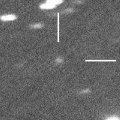
|
It keeps observable at 17 mag for a long time from 2010 to 2012.
Date(TT) R.A. (2000) Decl. Delta r Elong. m1 Best Time(A, h)
Aug. 15 3 47.39 20 38.0 9.017 8.949 82 17.8 5:15 (196, 33)
Aug. 22 3 46.13 20 41.0 8.874 8.931 89 17.7 5:07 (191, 34)
|

|
It keeps observable at 17-18 mag for a long time until 2011.
Date(TT) R.A. (2000) Decl. Delta r Elong. m1 Best Time(A, h)
Aug. 15 4 27.85 63 30.2 5.459 5.233 71 17.9 5:15 (191,-10)
Aug. 22 4 31.03 65 7.3 5.356 5.213 76 17.8 5:07 (189,-11)
|
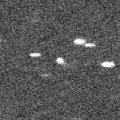
|
It will be getting lower in the evening sky after this. But it will be observable at 17 mag from spring to summer in 2010.
Date(TT) R.A. (2000) Decl. Delta r Elong. m1 Best Time(A, h)
Aug. 15 16 3.60 43 19.7 3.597 3.649 84 17.9 18:53 (175, 12)
Aug. 22 16 7.53 40 59.7 3.603 3.620 82 17.9 18:58 (170, 13)
|
|
![]()
 88P/Howell
88P/Howell C/2009 G1 ( STEREO )
C/2009 G1 ( STEREO ) 116P/Wild 4
116P/Wild 4 C/2007 N3 ( Lulin )
C/2007 N3 ( Lulin ) 64P/Swift-Gehrels
64P/Swift-Gehrels 29P/Schwassmann-Wachmann 1
29P/Schwassmann-Wachmann 1 C/2007 G1 ( LINEAR )
C/2007 G1 ( LINEAR ) C/2006 OF2 ( Broughton )
C/2006 OF2 ( Broughton ) 65P/Gunn
65P/Gunn 222P/2009 MB9 ( LINEAR )
222P/2009 MB9 ( LINEAR ) C/2008 P1 ( Garradd )
C/2008 P1 ( Garradd ) 81P/Wild 2
81P/Wild 2 (3552) Don Quixote
(3552) Don Quixote C/2008 N1 ( Holmes )
C/2008 N1 ( Holmes ) 67P/Churyumov-Gerasimenko
67P/Churyumov-Gerasimenko 199P/2008 G2 ( Shoemaker 4 )
199P/2008 G2 ( Shoemaker 4 ) P/2009 L2 ( Yang-Gao )
P/2009 L2 ( Yang-Gao ) P/2009 K1 ( Gibbs )
P/2009 K1 ( Gibbs ) C/2006 Q1 ( McNaught )
C/2006 Q1 ( McNaught ) C/2005 L3 ( McNaught )
C/2005 L3 ( McNaught ) C/2009 O4 ( Hill )
C/2009 O4 ( Hill ) C/2006 S3 ( LONEOS )
C/2006 S3 ( LONEOS ) 118P/Shoemaker-Levy 4
118P/Shoemaker-Levy 4 P/2003 A1 ( LINEAR )
P/2003 A1 ( LINEAR ) C/2008 FK75 ( Lemmon-Siding Spring )
C/2008 FK75 ( Lemmon-Siding Spring ) 47P/Ashbrook-Jackson
47P/Ashbrook-Jackson (3200) Phaethon
(3200) Phaethon C/2007 U1 ( LINEAR )
C/2007 U1 ( LINEAR ) P/2008 O2 ( McNaught )
P/2008 O2 ( McNaught ) 107P/(4015) Wilson-Harrington
107P/(4015) Wilson-Harrington P/2008 J3 ( McNaught )
P/2008 J3 ( McNaught ) C/2008 S3 ( Boattini )
C/2008 S3 ( Boattini ) C/2007 VO53 ( Spacewatch )
C/2007 VO53 ( Spacewatch ) C/2009 K2 ( Catalina )
C/2009 K2 ( Catalina )![]()

































